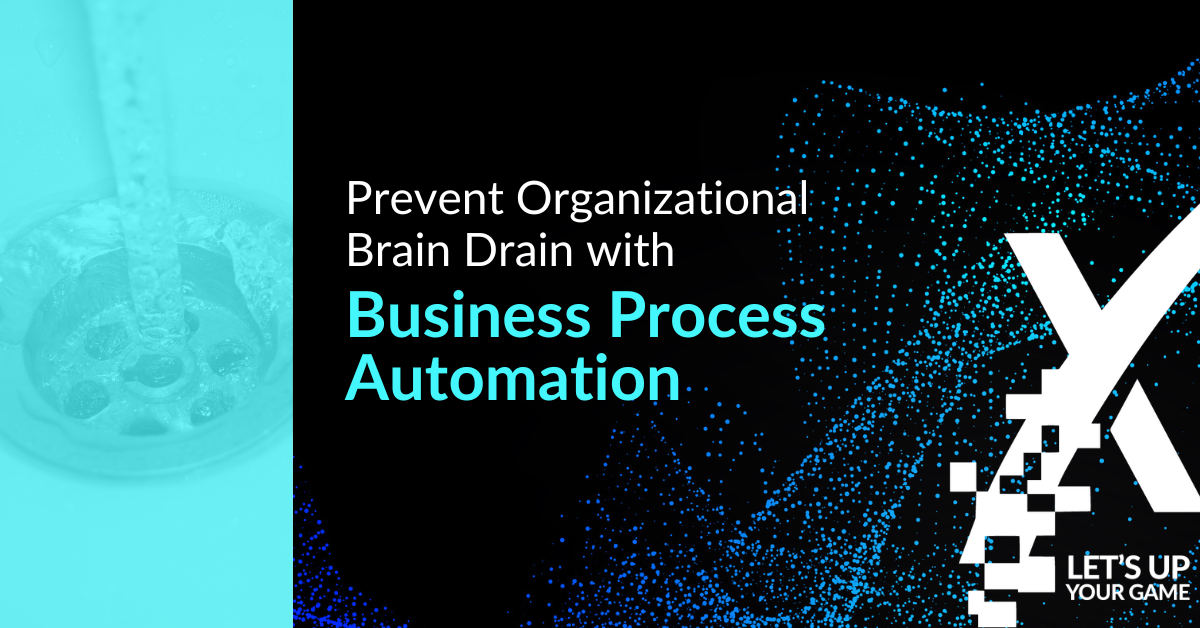Prevent Organizational Brain Drain with Business Process Automation

Is there someone in your organization who is the go-to person for a certain process or activity? What would happen if that person left your company? You’d be in bad shape if the activities that you count on to take place were facilitated by their magic spreadsheets and a knack for remembering all of the steps that need to happen.
The gap that appears when an employee leaves and no one really knows how to do what they have been doing is called brain drain. Brain drain burdens your business with extra costs and stress that could be avoided.
There’s a lot of work involved with getting a new person to take over the activities that your former employee was doing. When you have to recreate a whole process, steps can be missed. In the meantime, both customer and employee experience can suffer.
Benefits of Business Process Automation
One way to avoid the cost of brain drain is to automate business processes. With automation, you can create repeatable processes that reduce the risk of that process not working or being disrupted when key personnel leave.
Consistency is a huge benefit of process automation but there are other benefits that have a ripple effect on business operations. These are things like:
- Increased visibility to monitor progress.
- Shorter time to insert people into a process.
- Improved reporting capabilities.
- Eliminate possibility for errors.
- Decrease time needed to complete the process.
How Do You Find Potential Brain Drains?
When you want to prevent brain drain, the first place to look for business process automation opportunities is with those people who have figured out their own methods to get their job done. Take some time to sit beside these folks and ask them to show you how they do what they do.
Some signs that you might be looking at a potential brain drain include:
- Processes depend on spreadsheets and manual data entry.
- Only one person knows the status of a process.
- Process includes use of documents that aren’t shared.
- Process includes technology workarounds.
- When key person is not there, the process doesn’t get done.
Chances are good that once you find your first automation project and get it implemented, employees will go looking for more potential projects. When employees see real examples of automation at work, they’ll better understand what to look for, plus they’ll realize how automation sets them up for success.
Related: How to Find Opportunities for Process Automation
Automation Improves On-the-Job Experience
Automation shouldn’t be seen as a threat to your employees’ livelihood. On the contrary, automating processes equips your people to not just do their jobs, but to do a better job.
Let’s look at some of the possible components of an automation so that you can get a more clear idea of how automation can make tasks easier and faster for your people.
- Post messages to Microsoft Teams when a new task is created in Planner
- Request manager approval for a selected item
- Get a push notification when you get an email from your boss
- Send a customized email when new file is added
- Click a button to email a note
- Save Microsoft 365 email attachments to OneDrive
- Send approval and follow up via email
- Form processing to email and SharePoint
- Start approval for new documents and notify via Teams
- Get a notification when a new video matches a search on YouTube
How to Start Plugging Brain Drains
The first step in plugging potential brain drains is to realize that this isn’t just a process problem. It’s a business problem. Talk about the impact of the problem if you suddenly lost the people who are key to keeping operations going.
Propose business process automation as the solution to this business problem and outline the outcomes that are expected when automation is implemented. Don’t forget to include how you’ll measure success and what you expect the automation to cost. Automation is not as expensive as you might expect with the availability of low-code technology like Microsoft Power Apps.
Related: The Business Case for Business Process Automation
XPERTECHS Improves Client Operations with Automation
Here at XPERTECHS, we help clients identify possible applications for business process automation. Then we design and implement solutions. You can read a use case about a construction company that improved their onsite inspection process with automation and a mobile app.
Learn more about how we support clients with automation here.
